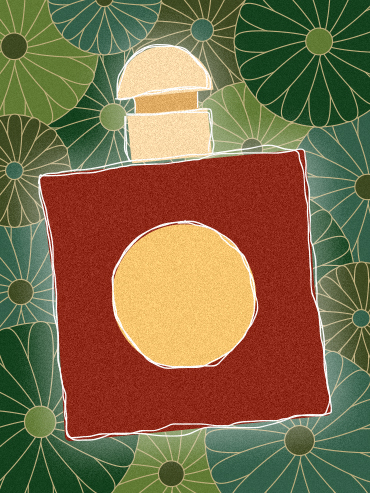Does Anyone Else Think It’s Weird That “Oriental” Is a Widely Used Perfume Category?
The term is outdated and offensive, so why are major perfume brands still using it to describe their products?


Full disclosure: The perfume world confuses the heck out of me.
This is slightly embarrassing to admit, considering I used to be a fashion and beauty editor, but I have to say, every time I’ve received press releases about new fragrances and their notes, my eyes would glaze over from the elaborate descriptions and fragrance world terms. Case in point: the description for Tom Ford’s F*cking Fabulous perfume (yes, that’s actually the name).
“With a name that says it all, the vibrant opening makes an instant statement as clary sage and fresh lavender command attention with aromatic foreplay. Delectable bitter almond and vanilla inflections infuse textural richness to the leather heart. Drenched in orris root from the iris flower, the full luscious body of the supple Italian plunge reveals its exquisite beauty. Addictive tonka bean and lavish leather drive the scent as amber undertones reverberate with a warm glow. Ultrafine blonde woods create a confident expression of pure luxury with a creamy finish.”
Sure, it’s an impressive use of descriptive language, but in order for me to *really* understand what a perfume is all about I have to (duh) smell it—and I’m sure this holds true for other fragrance amateurs like me.
That’s not to say fragrance descriptions are not useful—in fact, they are quite necessary in the perfume world in order to distinguish one scent from another and categorize perfumes into olfactory groups based on their main characteristics. I mean, how else would you create, describe or market a product that’s based on an elusive sense? But while the language of scent is important, lately I’ve been thinking about one fragrance term in particular that seems, well, pretty darn problematic: Oriental.
Where did the term “Oriental” come from?
In the fragrance world, “Oriental” is an official category of perfume that is distinguished by its warm, sensual notes (think vanilla, musk, spices and amber). Some classic Oriental perfumes include Yves Saint Laurent Opium, Thierry Mugler Angel, Tom Ford Black Orchid and Chanel Coco Noir. Other official categories of perfumes include Floral—which contains notes like jasmine, peony, gardenia, tuberose, lily of the valley, magnolia and mimosa—and Woody—which has elements like sandalwood, cedar, agarwood and patchouli. Interestingly, both Floral and Woody fragrance descriptors seem pretty self-explanatory, unlike Oriental. So where exactly did this term come from?
“The term is used primarily to describe perfumes with ingredients that were used in the very early days of perfume [making] in ‘The Orient,’ which was a historical term for… the Eastern World,” explains Jane Daly, a beauty and fragrance consultant, and creator of Eau de Jane. “It was about the ingredients associated with that part of the world…spices like vanilla, cinnamon, coumarin, tonka bean, gum resins (frankincense, myrrh, labdanum), oud and sandalwood, as well as ingredients that approximate those ‘warm’ scents.”
The first-ever perfume to use this term was Guerlain’s Shalimar, which launched in 1925 in Paris at the International Exhibition of Decorative Arts. The brand describes this fragrance as Oriental “because its suave gourmand notes recall the sweet balsams of the lands of the One Thousand and One Nights.” Guerlain also says the fragrance is Oriental “through its inspiration”: The story of a maharajah visiting Paris who told Jacques and Raymond Guerlain the story of the gardens of Shalimar, which sheltered the loves of the fifth Mughal emperor Shah Jahan and his wife, the Persian Mumtaz Mahal, for whom he built the Taj Mahal.
But outside of the perfume world, Oriental is a term that connotes nineteenth-century and early twentieth-century European colonialism. In his book Orientalism, Edward W. Said describes the term as “a sign of European-Atlantic power of the Orient” (i.e., the “East”) and a constructed, othering understanding of what Westerners believed the Orient to be: an exotic, mysterious and culturally opposite place from the West.
It’s not only an outdated term, but also a politically incorrect one—back in 2016, former U.S. President Barack Obama signed a bill eliminating all known uses of the term Oriental from federal law. At the time, congresswoman Grace Meng of New York, who sponsored the bill, referred to the term as “insulting,” “outdated” and “offensive” in an official statement. “Many Americans may not be aware that the word ‘Oriental’ is derogatory. But it is an insulting term that needed to be removed from the books,” said Meng.
Essentially, the term was used to fetishize and simultaneously degrade Eastern cultures that were portrayed as exotic and thereby less sophisticated than the West. It also paints a geographically and culturally vast group of people with a homogenous stroke: As Alice King writes, “The term clumsily groups together diverse cultures and ethnicities that’s only similarity brought to bear is they are non-European.”
So it’s clear that when the term is applied to people, it’s deemed offensive. But what about when it’s applied to a personal care product? Dr. Amy Hanser, associate professor at University of British Colombia’s Department of Sociology, finds this distinction to be particularly fascinating.
“It points to the ways in which we are sensitive to (negatively) racializing language when applied to people, but we might fail to recognize racializing discourse that is not applied directly to human bodies,” she says. “But the idea of a perfume being an ‘Oriental’ fragrance might indeed be drawing upon stereotypes about a region (and its people) that make the term problematic when applied to people.”
The great debate on Oriental fragrances
Given the problematic implications of the term, it seems bizarre that it’s still being used to describe fragrances, right? But to traditional perfumers and perfume aficionados, no—especially since Oriental is an “official” classification in the perfume world.
“I see [the term] as a compliment, certainly not as a negative,” argues Marian Bendeth, a global fragrance expert and owner of Sixth Scents. “It’s where it originates, and it’s a beautiful thing and it certainly helps me because I deal with classifications all the time.”
Bendeth adds she sees the term not as cultural, but as a classification of the geographic origin of certain fragrance notes. “China does have a beautiful culture, as does Japan, as does the whole Far East in terms of perfumery. This is where [the term Oriental] comes from, this is where it was discovered, this is where it’s grown and replicated,” she says. “It’s a far leap to say, ‘Oh, we’re poking fun at something from the Far East.’ It’s something that China should be extremely proud of because it’s part of history.”
Others, however, firmly believe a change in classification terms should be made.
Alexa Nishimoto, a freelance fashion designer and employee of the Japanese American National Museum in Los Angeles, says: “It feels like [brands] attempt to use one universal word to convey all Asian cultures, which is reductive to those who know that the nuances of each culture can be vastly different and don’t fall under just one umbrella term.”
Dana El Masri, an independent perfumer and creator of Jazmin Saraï perfumes, agrees: “[The term Oriental] is outdated and unnecessary. It also doesn’t say much about the fragrance family and has become more of a reference to a ‘spice’ structure that was created in the 1920s than anything else. It is too broad a reference and perpetuates a typically Western/Occidental point of view.” She adds, “There are more beautiful and descriptive words in the English language to use than that.”
So what word should perfumers use instead?
Will there be a push for a change in this classification term? Julianne Lee, a member on the board of directors at the Los Angeles-based non-profit Institute for Art and Olfaction (IAO), says although it would require a restructuring of fragrance wheels that currently use this category, it’s definitely possible.
“I understand that the term is not one that is easy to sidestep for those in the fragrance community as so-called ‘Oriental’ perfumes are crucial to perfume history,” she says. “However, I do find it a lazy and harmful terminology. We can certainly do better today.”
The IAO itself actively refrains from using Oriental as a perfume classification. “When we use the word here at the IAO—which is rare—we always use it in heavy airquotes, and with the caveat that this is an historical term, and needs changing,” says Saskia Wilson-Brown, the founder and executive director of the organization. She notes that if absolutely necessary, the IAO says “the category most commonly known as Oriental, which needs renaming.” A mouthful, sure, but it’s true.
There are certainly other options that perhaps roll off the tongue a little easier, and many people have already made good suggestions. For example, cultural critic Rachel Syme of The Drydown settled on the replacement term “spicebomb” in their December 2017 newsletter, “#15: Spice World.”
El Masri suggests breaking down the fragrance family into different subfamilies and referring to regions, doing away with the all-encompassing term altogether. “There are huge differences between a fragrance created in Malaysia by Malay people than a Japanese one, obviously, so why not classify it as such?” she says.
While doing a residency at the IAO, El Masri actually brainstormed alternative classification names with others at the organization. They came up with using words that describe the actual olfactory notes, like “ambery” or finding words in the respective languages (for example, Hindi, Vietnamese, Arabic) for inspiration.
Lee notes that in terms of olfactory notes, Oriental fragrances can generally be divided into two categories: those that incorporate the “ambreine” accord (bergamot, vanillin, rose) and those that use the “mellis” accord (benzyl salicylate, eugenol, lily-of-the-valley, spices). However, she says contemporary Oriental fragrances have branched out vastly from these accords, and may not even warrant the Oriental label at all. “Oftentimes, they are mere attempts at populating the ‘Oriental’ category, clearly visible from the marketing narrative and strategy,” she says.
What would it take to get rid of this term?
Though reclassification would be a slow process, El Masri says it’s still doable. “We would have to access all of the perfume classifications that exist, which requires cooperation from larger companies. We have to get enough people interested in changing it and recognizing that it’s an issue to begin with,” she says.
As for those larger companies? Well, it’s hard to gauge whether they will break tradition. Daly believes there will be resistance, and perhaps she’s right. When contacted about the matter, Yves Saint Laurent fragrances declined to share a statement, while Chanel’s response was, “We wont be able to participate in the story at this time.”
What would be interesting to see is if major fragrance houses would change the “official” terminology if consumer pressure is applied. But in order for that to happen, consumers may need to become more educated about the perfume world, its terminology and its descriptors. I personally did not realize Oriental was an official category of perfume until I worked behind the scenes as a fashion and beauty editor. But now that I do, I’m avoiding all fragrances described with this term, no matter how good they smell.
As a Chinese-Canadian woman, I take issue with the fact that so-called Oriental perfumes don’t represent Asian cultures at all: Like the origins of the term itself, Oriental perfumes are based off of a construct of what Westerners perceive the East to be. There is no real homage to Asian countries, but rather brands taking “inspiration,” like Guerlain with its Shalimar perfume (and for further proof, just look brand’s 2013 “Legend of Shalimar” commercial starring Natalia Vodianova). It’s makes me mad, and I have to think that other Asian consumers would feel the same way.
As Lee says, “The perfume industry must acknowledge that its producers and consumers are internationally diverse, and not limited to the Eurocentric perspective which gave root to such categories.”








